
Paul Smith, Melrose Avenue, LA (#7) by John Tierney
Like many artists before him, John Tierney is fascinated by light – the way it reflects off surfaces, creates shadows, sets mood, saturates colors and highlights elements of a building, street, person or landscape. While this English artist grew up painting in his native country, it was his travels abroad, particularly to Los Angeles, New York and Helsinki, where each of his three grown sons now live, that exposed him to very different lighting conditions and allowed him to push the boundaries of his work.
When I was introduced to Tierney’s images of Los Angeles and Joshua Tree National Park by his LA-based son, I was impressed by what I saw and found that they resonated with me. So I contacted him to find out more about his work. I’m not the only one who’s taken an interest. One of his paintings has found its way onto a garment any fashionista would covet. More on that later.
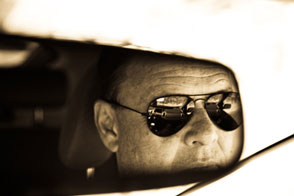
John Tierney. Photo from his web site
From an early age Tierney found that his innate artistic ability was both recognized and encouraged. That aptitude led him to serve an engineering apprenticeship and become a design draftsman prior to attending university at age 23, an experience that taught him the use of proportion and scale, among other basic skills. Despite this training, however, Tierney considers himself a self-taught artist.
Although he painted on and off over the years, Tierney didn’t pursue the life of an artist. Instead, he went the academic route, ultimately becoming a professor of criminology at Durham University. The responsibilities of his successful academic career left little time to pursue outside interests, and so painting took a back seat to research, writing and teaching. It was only after retiring from the university in 2010 that he finally had the time to focus on his art. And focus he has. In less than two years, Tierney has produced an impressive body of work.
While retirement provided Tierney with the time to paint, it was his family visits to LA, which began about seven years ago, that stimulated his desire for artistic expression and gave him a compelling subject on which to concentrate. “I was fascinated by the city and its light,” Tierney said. “In the same way David Hockney in the 60s became enamored of the place and saw enormous potential. So this new wave of [my] art actually began by focusing on Los Angeles and Joshua Tree as well.”
Tierney’s periodic visits to Los Angeles revolve around his son and daughter-in-law, but they also afford ample opportunities to explore the region. Whether it’s hiking in the local mountains, walking new neighborhoods or spending time in the desert, Tierney makes a point of bringing along his camera to record whatever catches his eye. Out of this large collection of images, he then selects the few photographs that serve as the starting points for his paintings.
“I like the way photographs freeze time and present me with accidents,” Tierney said. “It’s a kind of serendipity of frozen time. And I love those surprises. You can’t just come up with that kind of stuff. So there are people who populate my paintings who are there by accident. But I’ll move them around, because there is still the subjective, aesthetic, intellectual process on my part where I’m trying to get some kind of proportion, some balance.”
His painting “Cobble Hill Cinema,” which depicts the exterior of a Brooklyn Heights, NY theater, embodies the serendipity he embraces. “We were walking past the cinema and people were coming out with two or three children. What I didn’t realize when I took the photograph was there was a little girl there in the most amazing red frock with her arm over her head in a very unusual pose. And I still can’t work it out – why was she dressed like that? I love that idea. If you look at the painting she is clearly the focal point and yet that is by accident. I didn’t see her at the time.”
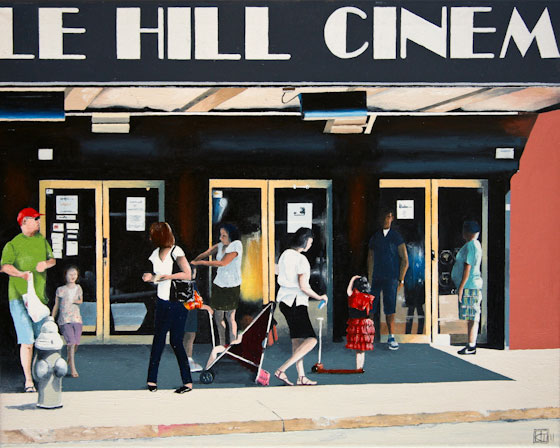
Cobble Hill Cinema, Brooklyn Heights, NY by John Tierney.
While working from photographs enables Tierney to capture moments in time that often include surprises, painting in places that are very different from the small, medieval city of Durham that he calls home presents equally compelling opportunities to depict subjects that are unlike anything he’d find in England. Take for example his painting titled “Rage Against the Machine.” It depicts a storefront on Melrose called Fuk U Lingerie – Love Shop. “There is no way you’d be able to do that in England. You just cannot do it,” John said. “I was just intrigued by that. I scribbled in my own graffiti” in the painting.
Tierney’s fascination with Los Angeles is evident when looking at his other works as well. On his web site you’ll find depictions of Melrose Avenue streetscapes, the Santa Monica Pier, and the Chateau Marmont, among others. You’ll also find a series of paintings that portrays the desert in and around Joshua Tree.
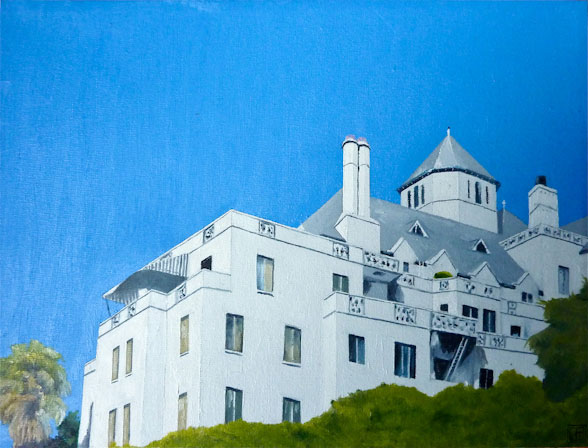
Chateau Marmont, LA by John Tierney
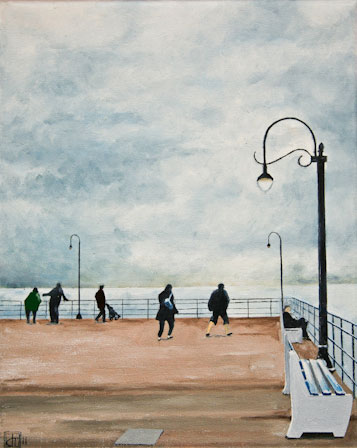
Windy January, Santa Monica Pier by John Tierney
While I admire and am drawn to many of the LA paintings, particularly “Los Feliz Archway,” “Windy January, Santa Monica Pier,“ “Paul Smith, Melrose Avenue, LA (#7)” and “No Parking, LA,” it’s Tierney’s Joshua Tree works that really speak to me. I’ve camped in Joshua Tree many times over the years and have a deep love for that part of southern California. Tierney’s work adeptly captures the stillness and quiet that I associate with the desert, the subtle hues and varied shapes of the rock formations, and the bright light, deep shadows and crisp lines that demarcate the mountains from the blue sky. He also conveys the spaciousness and depth of the landscape and the solitude that one can feel in the remote expanses of our desert communities.
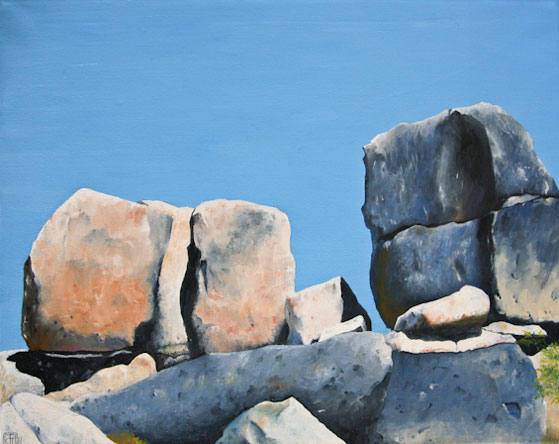
Rocks, Joshua Tree National Park (#2) by John Tierney
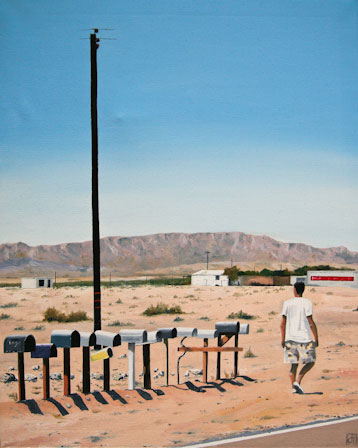
Mailboxes, Naborly Rd, Twentynine Palms, CA (#1) by John Tierney.
Tierney’s paintings are rendered in a highly realistic style. He uses oil paint to enhance the luminosity of each picture and his compositions are distinguished by their vibrant colors, the interplay of light and shadow, and the juxtaposition of form and space. According to Tierney, his primary influences are Edward Hopper and David Hockney.
“What I’m trying to do is allow the viewer, no matter where they are, to look at the painting and just have a sense of quiet, of the silence and the luminosity of the place,” Tierney said about his desert paintings. “What intrigues me is the very sharp edge at the top of the mountains against the blue of that sky. It’s so different from anything else I’d experienced, certainly from the green fields of England.”
Not surprisingly, Tierney sees similarities between the desert and Los Angeles. In the city, “…there are a lot of flat roofs because of the climate, there are blue skies, which I love, and which throw up very dark shadows, which I love. The tops of the buildings against the sky are very much like the tops of the mountains against the sky in Joshua Tree – there’s a very sharp line between the roof and the blue sky.”
Just as Los Angeles became one of Tierney’s primary muses, the city has helped propel him to greater prominence. After completing a series of paintings depicting the distinctive Paul Smith clothing store on Melrose, Tierney’s son encouraged him to give one to the famous British fashion designer. As luck would have it, Smith loved the painting and decided to feature it on a women’s scarf that is now sold exclusively in the Melrose store.

Painting of the Paul Smith store on Melrose Avenue by John Tierney and the Paul Smith scarf based on that image.
In addition to raising Tierney’s profile and getting his work in front of more people, that project has apparently opened the door to others that are currently in the works and about which Tierney couldn’t elaborate at the present time. I look forward to seeing what comes out of future collaborations.
For those who would like to see Tierney’s paintings in person, as I would, patience will be necessary. They are not currently found in any galleries in the Los Angeles area. It is possible, however, to see many of his pictures online and to purchase some of them. If you’re interested, I encourage you to contact him directly via his web site. I know several of his works would make a wonderful addition to my family’s modest collection of Los Angeles paintings.


Love the painting of the Chateau Marmont; it looks very peaceful and serene in the painting. Very different from the hustle and bustle of the actual hotel on Sunset.